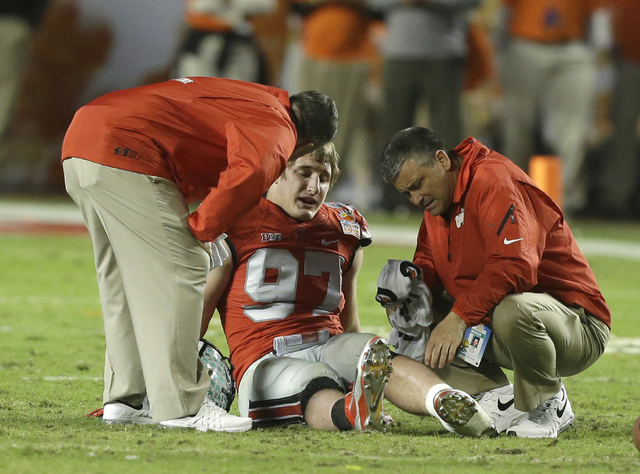SCOTTSDALE, Ariz. — Ohio State’s defense had been laid to waste by Clemson in the 2014 Orange Bowl, the last in a series of lousy performances by the Buckeyes that caused a promising season to end with a thud. ADVERTISING
SCOTTSDALE, Ariz. — Ohio State’s defense had been laid to waste by Clemson in the 2014 Orange Bowl, the last in a series of lousy performances by the Buckeyes that caused a promising season to end with a thud.
Coach Urban Meyer had seen enough. He ordered defensive coordinator Luke Fickell to blow up everything and start anew.
“His mindset was: I want to be aggressive. I want to challenge, challenge, challenge,” Fickell said Wednesday.
The result was a defense built around a scheme called press quarters, a zone coverage that cuts the field into four parts but plays a lot like man-to-man and relies heavily on defensive backs to win head-to-head matchups with receivers. Since then the Buckeyes’ defense has improved every season. When No. 2 Ohio State (11-1, No. 3 CFP) faces No. 3 Clemson (12-1, CFP No. 2) in the Fiesta Bowl semifinal on Saturday at University of Phoenix Stadium, the Tigers will be dealing with a very different team.
“We’re going to be aggressive as hell,” Fickell said. “We’re not going to give anything easy. We’re going to suffocate offenses in everything that we do, which means at times you’re hanging yourself out.”
The 2013 Buckeyes started 12-0 and went to the Big Ten title game needing a victory to reach the BCS championship. The defense had been OK for most of the year, but a 42-41 victory against Michigan to end the regular season was an ominous sign. Ohio State was pounded 34-24 by Michigan State in the conference title game, ending national title hopes. Then against Clemson in South Florida, the Buckeyes lost 40-35 and allowed 576 yards.
Tajh Boyd (378 yards passing and 127 rushing) and Sammy Watkins (16 catches for 227 yards) had their way with the Buckeyes, who played cautiously, almost tentatively, in fear of giving deep throws to Clemson’s speedy receivers.
Clemson co-offensive coordinator Jeff Scott, who was receivers coach back then, said the Tigers hardly practiced the quick passes and screens that were a big part of their offense leading up to the Orange Bowl because they figured Ohio State would hug the line of scrimmage to take them away.
“Then we got out in the game and they were playing off of them and we ended up throwing it about 12 times,” Scott said. “You don’t see that now.”
Meyer hired Chris Ash to be co-coordinator not long after the Orange Bowl. Ash, who left after last season to become the head coach at Rutgers, had coached press quarters at Wisconsin and Arkansas. Fickell said they looked at the success Michigan State had with its press quarters coverage under then-coordinator Pat Narduzzi. They studied some Oklahoma State and even the Baltimore Ravens and came up with a version that works for Ohio State.
Ash said in a phone interview the big difference between the way Ohio State plays press quarters and many other teams do is the Buckeyes’ scheme has the flexibility to put extra coverage on a single great receiver. They called it the Sammy Watkins Rule, he said.
This season the Buckeyes’ defense ranks third in the nation in yards per play (4.24) and yards per game (281.6), and while they are talented at each level of the defense, the secondary stands out.
“On video through every game, they’re press just about every single play,” Scott said. “And I think one reason is they feel confident in the guys on the perimeter. Two or three of the best corners in college football.”
Gareon Conley and Marshon Lattimore are the starters and Denzel Ward is first off the bench.
“I think they’re similar in that they’re all pretty long guys and they’re similar in that they can all run well,” co-defensive coordinator and secondary coach Greg Schiano said.
Conley, a 6-foot, 190-pound junior, is the most versatile. He can line up wide or match up with slot receivers. Lattimore is best at playing the ball. Schiano said the 6-foot, 192-pound sophomore could be one of the team’s best receivers.
Ward is the smallest at 5-10, 185, but may be the most explosive athlete of the bunch.
“What I look for when I turn on a video and I start watching for the first time it’s: ‘Who can we pick on?’” Scott said. “Usually everybody has that one corner that’s really good. But then outside of that the other corner is just OK. So you’re trying to find matchups. When I watch the entire season of Ohio State, you don’t see that. I’m like, all right, all these guys can play.”
Backing up those corners is maybe the best safety in the country in All-American Malik Hooker, who returned three of his six interceptions for touchdowns and has sideline-to-sideline range.
“They don’t ask those guys to do a whole lot. They just rely on their length and their speed, their instincts and let them go play,” Clemson co-offensive coordinator Tony Elliott said.



